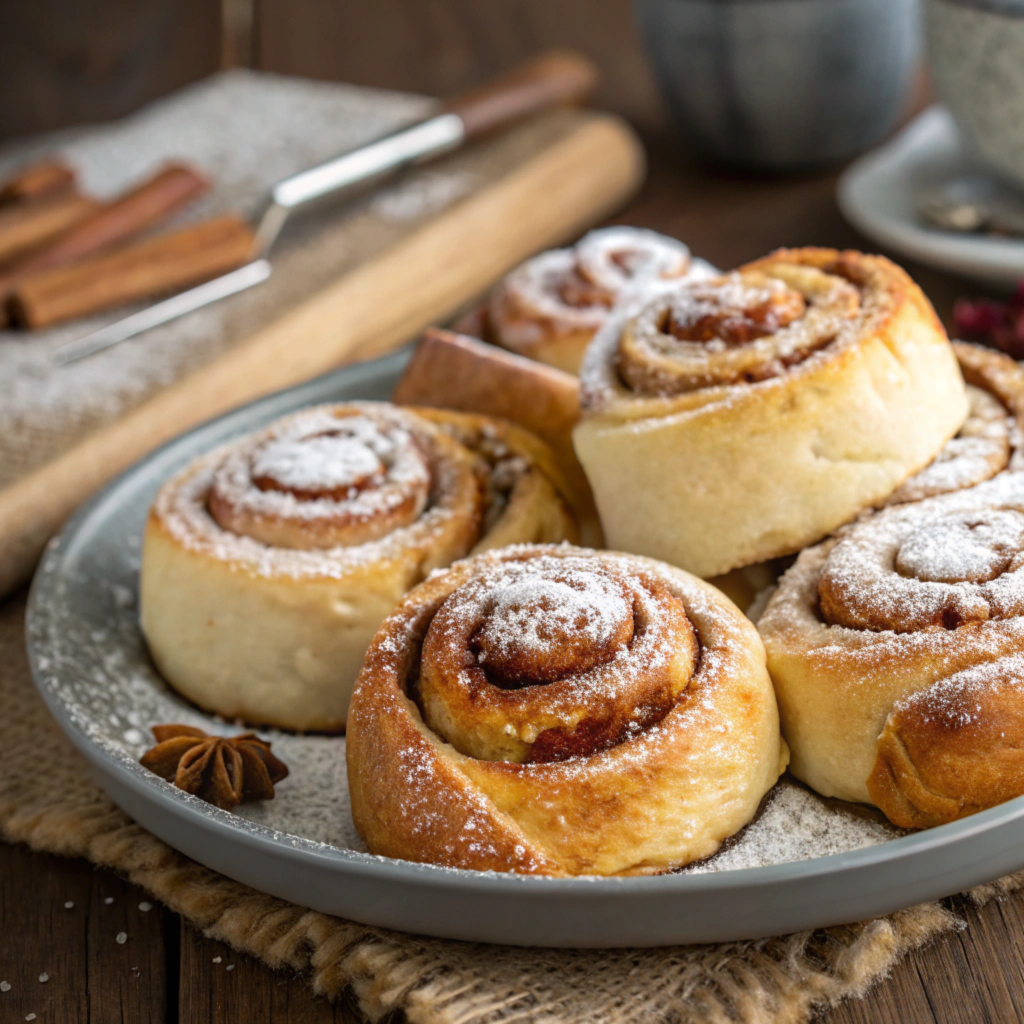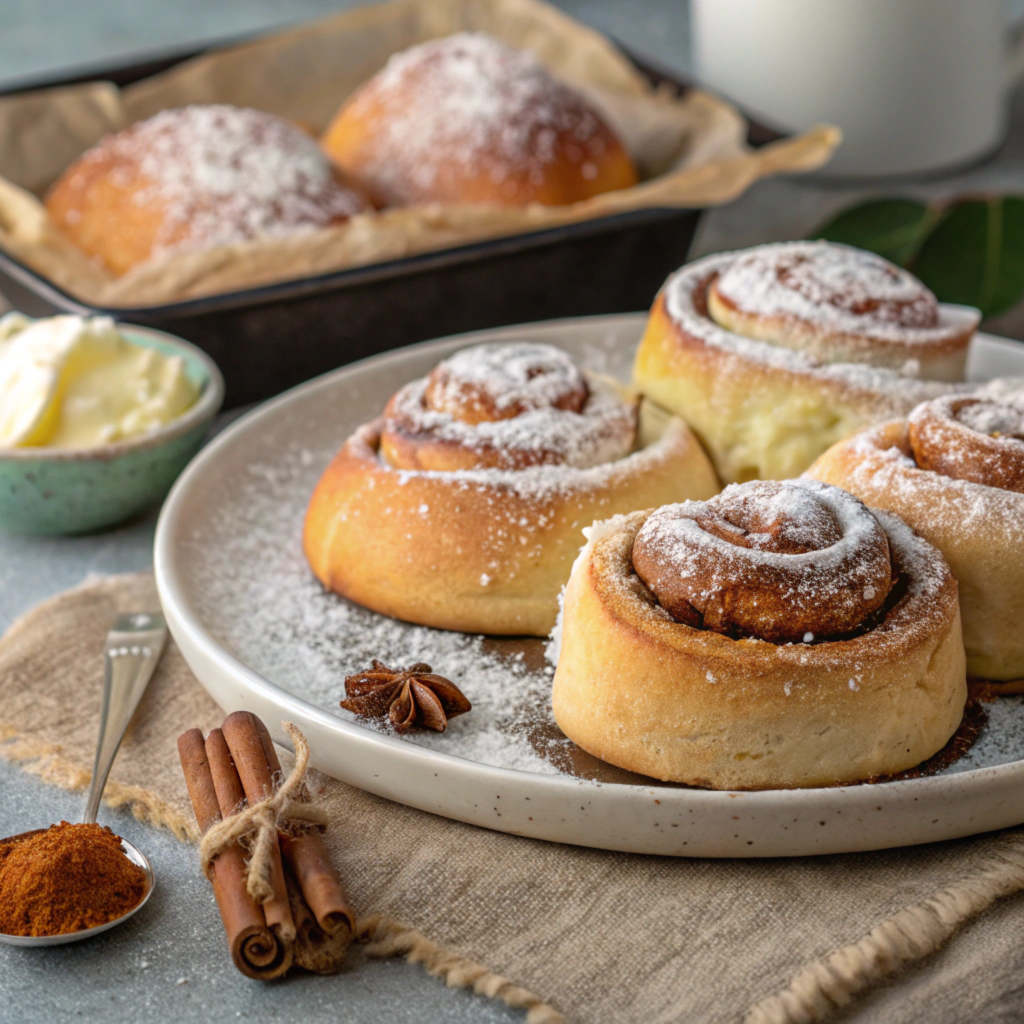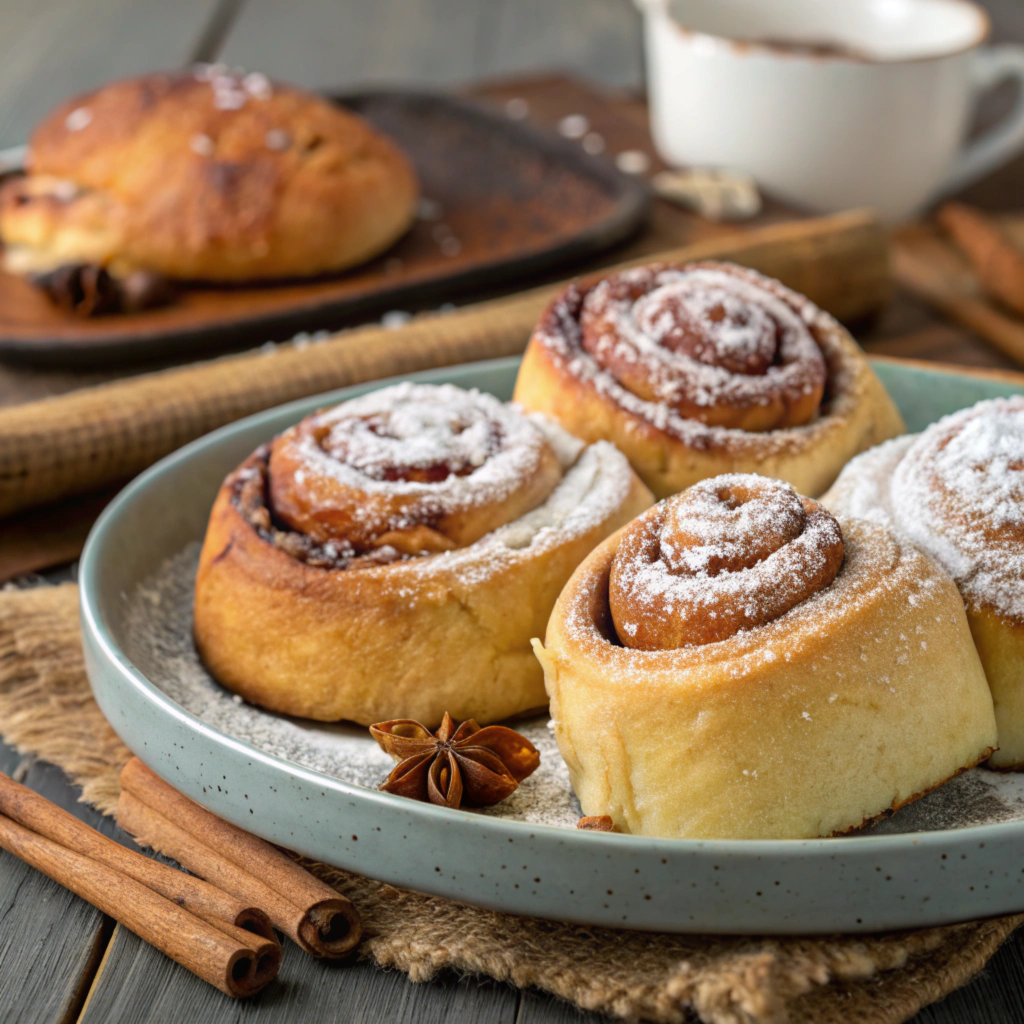
Cinnamon rolls are a beloved treat enjoyed worldwide for their soft, sweet, and spiced flavors. Understanding the essential ingredients that go into making cinnamon rolls can help home bakers create perfect rolls every time. Each ingredient serves a specific purpose, contributing to the dough’s structure, the filling’s richness, and the topping’s creamy sweetness.
Overview of Cinnamon Rolls
A cinnamon roll is a sweet, spiraled pastry made from enriched dough filled with a cinnamon-sugar mixture and often topped with a creamy glaze or frosting. Its popularity spans across breakfast menus, holiday gatherings, and dessert tables due to its soft texture and warm, spiced aroma.
The key to making the perfect cinnamon roll lies in balancing the right ingredients, ensuring the dough is tender yet strong enough to hold its signature swirl. This section breaks down the most important ingredients used in dough preparation, filling creation, and topping options.

Basic Ingredients for Dough
The dough is the foundation of a soft and fluffy cinnamon roll. It requires several key ingredients that contribute to its elasticity, texture, and rise.
1. All-Purpose Flour
- Function: Flour provides the structure for the dough by forming gluten when mixed with liquid. This elasticity allows the dough to stretch while holding its shape.
- Best Type: Use unbleached, all-purpose flour for the perfect balance of protein and tenderness. For even softer rolls, try using bread flour, which has a higher protein content.
2. Yeast: The Rising Agent
- Function: Yeast is responsible for leavening the dough, making it rise and creating an airy, light texture.
- Types of Yeast:
- Active Dry Yeast: Must be dissolved in warm liquid before use.
- Instant Yeast: Can be added directly to dry ingredients.
Pro Tip: Use warm milk or water around 110°F (43°C) to activate yeast effectively. Adding a bit of sugar helps yeast feed and produce the gases that make the dough rise.
3. Granulated Sugar
- Function: Sugar feeds the yeast, helping the dough rise while adding sweetness. It also contributes to the dough’s golden-brown color when baked.
Pro Tip: Avoid reducing sugar too much, as it can affect both the sweetness and texture of the dough.
4. Salt
- Function: Salt balances sweetness while enhancing the dough’s flavor. It also helps strengthen the gluten structure, improving elasticity.
Tip: Be careful not to add salt directly to the yeast, as it can inhibit yeast activity.
5. Butter: Richness and Tenderness
- Function: Butter adds richness, moisture, and flavor. It softens the dough, giving the rolls their signature tender texture.
Best Practice: Use softened, unsalted butter for better control of the dough’s salt content.
6. Eggs
- Function: Eggs add structure, richness, and moisture. They also contribute to the rolls’ soft texture and help create a golden-brown crust.
Tip: Use room-temperature eggs for smoother mixing and even distribution throughout the dough.
7. Milk
- Function: Milk enhances the dough’s softness and richness. It also improves the dough’s overall flavor.
Best Choice: Use whole milk for the best results, as its fat content helps create a tender dough.
Filling Ingredients
The cinnamon-sugar filling is what makes cinnamon rolls irresistibly sweet and flavorful. Its combination of butter, sugar, and spices creates the signature swirl found in every bite.
1. Brown Sugar
- Function: Brown sugar adds sweetness and depth of flavor due to its molasses content.
- Best Type: Use dark brown sugar for a richer, caramel-like taste or light brown sugar for a milder sweetness.
2. Ground Cinnamon
- Function: Cinnamon is the core spice that defines cinnamon rolls. Its warm, aromatic flavor blends perfectly with the sugar and butter.
Tip: Use freshly ground cinnamon for a more intense flavor.
3. Butter (Softened)
- Function: Butter keeps the filling moist while creating a caramel-like layer as the rolls bake.
Tip: Spread softened butter evenly across the dough before adding the cinnamon-sugar mixture.
4. Optional Add-Ins
- Raisins or Dried Cranberries: Add natural sweetness and texture.
- Chopped Nuts (Pecans or Walnuts): Offer a crunchy contrast.
- Spices (Nutmeg or Cardamom): Enhance the filling’s warmth and complexity.
Topping Ingredients
The topping adds a final layer of sweetness and creaminess to cinnamon rolls. Whether you prefer a classic glaze or rich cream cheese frosting, these ingredients create the ultimate finishing touch.
1. Cream Cheese Frosting
Ingredients:
- Cream Cheese: Adds a tangy, creamy richness.
- Powdered Sugar: Sweetens the frosting while keeping it smooth.
- Butter: Adds creaminess and helps create a spreadable texture.
- Vanilla Extract: Enhances the frosting’s overall flavor.

2. Vanilla Glaze
Ingredients:
- Powdered Sugar: The base for a smooth, sweet glaze.
- Milk or Heavy Cream: Adjusts the glaze’s thickness.
- Vanilla Extract: Adds a hint of warmth and sweetness.
Tip: Drizzle the glaze over the rolls while they’re still warm for a melt-in-your-mouth effect.
3. Additional Toppings
- Caramel Sauce: Adds a sticky-sweet finish.
- Chopped Nuts or Sprinkles: Add texture and visual appeal.
- Cinnamon Sugar Dusting: Creates a lightly sweet crust.
Part 2: Dough Preparation and Filling Process
Making perfect cinnamon rolls starts with proper dough preparation and a carefully layered filling. This process involves activating the yeast, mixing and kneading the dough, and applying the sweet, spiced filling before rolling and shaping the rolls. Every step is essential to creating soft, fluffy, and delicious cinnamon rolls.
1. Making the Dough
The dough serves as the base of cinnamon rolls, creating their soft, tender texture. Here’s a step-by-step guide on how to prepare the dough for the best results.
1.1. Activating the Yeast
Proper yeast activation is crucial for creating a light and fluffy dough.
Steps to Activate Yeast:
- Warm the Milk:
- Heat whole milk to 110°F (43°C). Ensure it’s warm but not too hot, as extreme heat can kill the yeast.
- Add Sugar:
- Stir in 1 tablespoon of sugar to feed the yeast.
- Add the Yeast:
- Sprinkle active dry yeast over the warm milk. Let it sit for 5-10 minutes until it turns frothy.
Pro Tip: If the mixture doesn’t foam, the yeast may be inactive. Start over with fresh yeast and warm liquid.
1.2. Mixing and Kneading the Dough
A properly mixed dough creates the structure needed for fluffy cinnamon rolls.
Mixing Process:
- Combine Ingredients:
- In a large bowl, mix flour, salt, granulated sugar, eggs, softened butter, and the activated yeast mixture.
- Mix Until Smooth:
- Use a stand mixer with a dough hook or mix by hand. Combine ingredients until the dough comes together.
Kneading Process:
- Knead the Dough:
- Knead for 8-10 minutes until the dough is soft, elastic, and slightly sticky.
- Test the Dough:
- Press the dough gently—it should bounce back when touched.
Pro Tip: Avoid adding too much flour, as it can make the dough tough and dry.
1.3. First Rise Process (Proofing)
Allowing the dough to rise properly creates a soft and airy texture.
How to Proof the Dough:
- Transfer to a Bowl:
- Place the dough in a greased bowl and cover with a damp cloth or plastic wrap.
- Let It Rise:
- Allow the dough to rise in a warm, draft-free spot for 1-2 hours until it doubles in size.
Tip: If the kitchen is cold, place the bowl in a slightly warmed (but off) oven for even proofing.
2. Rolling Out the Dough
After the dough has risen, it’s time to roll it out for the filling.
Steps:
- Flour the Surface:
- Lightly flour your work surface to prevent sticking.
- Roll the Dough:
- Roll the dough into a large rectangle, approximately ¼ inch thick and 16×12 inches in size.
Pro Tip: Ensure the dough is evenly rolled to avoid uneven baking.
2.1. Spreading the Filling
The filling is what defines cinnamon rolls, creating that iconic swirl.
Filling Ingredients:
- Softened Butter (Room Temperature): Creates moisture and helps the filling stick.
- Brown Sugar: Adds sweetness and a rich, caramel-like flavor.
- Ground Cinnamon: Provides warmth and signature spiced flavor.
How to Apply the Filling:
- Spread Butter Evenly:
- Use a spatula or butter knife to spread softened butter over the rolled-out dough, covering the entire surface.
- Sprinkle the Filling:
- Evenly sprinkle the brown sugar and cinnamon mixture over the buttered dough. Ensure the edges are well-covered.
Pro Tip: Add extras like chopped nuts, raisins, or chocolate chips for variety.
2.2. Rolling and Shaping the Rolls
This step creates the signature spiral shape of cinnamon rolls.
How to Roll the Dough:
- Roll Tightly:
- Starting from the long side, roll the dough tightly and evenly into a cylinder.
- Seal the edge by pinching the seam closed.
- Cut Even Rolls:
- Use a sharp knife or unflavored dental floss to cut the dough into 12-15 equal rolls.
- Wipe the knife after each cut for cleaner slices.
Pro Tip: Tightly rolled dough creates defined swirls and evenly baked rolls.
2.3. Second Rise (Final Proofing)
After cutting, allow the cinnamon rolls to rise again before baking.
Steps:
- Arrange Rolls in a Baking Dish:
- Place the rolls in a greased baking dish, leaving some space between them for rising.
- Let Them Rise:
- Cover the dish loosely with plastic wrap or a damp cloth. Let the rolls rise for 30-45 minutes until puffy and nearly doubled in size.
Tip: If the rolls seem slow to rise, place them in a warm oven (turned off) to speed up proofing.
2.4. Preheating the Oven
Proper oven preparation ensures even baking.
Preheating Guidelines:
- Preheat the oven to 350°F (175°C) while the rolls are rising.
3. Baking the Cinnamon Rolls
The final step is baking the rolls to golden-brown perfection.
How to Bake:
- Bake for 20-25 Minutes:
- Place the rolls in the preheated oven and bake for 20-25 minutes until lightly golden brown.
- Check for Doneness:
- The rolls should be soft in the center but fully cooked.
- Use a thermometer to ensure the internal temperature reaches 190°F (88°C).
Part 3: Toppings, Variations, and Serving Ideas for Cinnamon Rolls
Creating the perfect cinnamon roll doesn’t end with baking—it’s all about the toppings, unique recipe twists, and creative ways to serve these delicious treats. Whether you prefer a classic cream cheese frosting, sweet vanilla glaze, or a custom topping, this section explores the best finishing touches, flavor variations, and serving suggestions for cinnamon rolls.
1. Classic Toppings for Cinnamon Rolls
The topping is what turns a good cinnamon roll into an unforgettable dessert. From creamy frostings to simple glazes, these toppings add extra sweetness and visual appeal.
1.1. Classic Cream Cheese Frosting
Cream cheese frosting is the most popular topping for cinnamon rolls, thanks to its tangy, rich flavor that balances the rolls’ sweetness.
Ingredients:
- Cream Cheese (Softened): Adds a tangy and creamy base.
- Powdered Sugar: Provides sweetness and a smooth texture.
- Butter (Softened): Adds richness and helps the frosting spread easily.
- Vanilla Extract: Adds warmth and depth of flavor.
How to Make It:
- Beat softened cream cheese and butter until smooth.
- Gradually add powdered sugar while mixing on low speed.
- Add vanilla extract and beat until fluffy.
- Spread over warm cinnamon rolls for a melty, decadent finish.
1.2. Vanilla Glaze Topping
A vanilla glaze is light, sweet, and simple, perfect for those who prefer a less heavy topping.
Ingredients:
- Powdered Sugar: The glaze’s sweet base.
- Milk or Heavy Cream: Adjusts the thickness.
- Vanilla Extract: Enhances the sweetness with a warm aroma.
How to Apply It:
- Drizzle the glaze over warm cinnamon rolls using a spoon or piping bag.
- Add more glaze for extra sweetness.
1.3. Cinnamon Sugar Sprinkle
For a simpler topping, sprinkle a cinnamon-sugar mix over freshly baked rolls.
How to Use It:
- Combine granulated sugar and ground cinnamon in a small bowl.
- Sprinkle evenly over the rolls after baking for extra sweetness and a touch of crunch.
1.4. Caramel Sauce Drizzle
A caramel sauce topping turns regular cinnamon rolls into a luxurious dessert.
How to Make It:
- Heat butter, brown sugar, and heavy cream over medium heat until smooth and bubbly.
- Drizzle over the rolls for a sticky, gooey finish.
2. Unique Cinnamon Roll Variations
There’s no limit to the creative combinations you can try with cinnamon rolls. Here are some popular flavor twists to elevate your baking game.
2.1. Nut and Fruit Additions
Add texture and sweetness by including nuts or dried fruits in your cinnamon rolls.
Popular Add-Ins:
- Pecans or Walnuts: Add crunch and nutty richness.
- Raisins or Cranberries: Offer a sweet, chewy texture.
- Chopped Apples or Pears: Perfect for fall-inspired cinnamon rolls.
Pro Tip: Sprinkle nuts and dried fruits into the cinnamon-sugar filling before rolling the dough.
2.2. Caramel Apple Cinnamon Rolls
This fall-inspired twist combines cinnamon rolls with the flavors of caramel apples.
How to Make It:
- Add diced apples to the filling.
- Top with homemade caramel sauce after baking.
Best Served With: A dollop of whipped cream and a sprinkle of cinnamon.
2.3. Chocolate Cinnamon Rolls
For chocolate lovers, try adding cocoa powder or chocolate chips to the filling.
How to Make It:
- Mix brown sugar, cocoa powder, and chocolate chips into the filling.
- Top with a chocolate glaze made from melted chocolate and cream.
Best Pairing: Serve with a glass of cold milk or hot cocoa.
2.4. Savory Cinnamon Rolls
Savory cinnamon rolls are perfect for brunch or appetizer platters. Swap the sweet filling for cheese, herbs, and spices.
Savory Fillings:
- Cheddar & Garlic Butter: Combine melted butter, minced garlic, and shredded cheddar cheese.
- Spinach & Feta: Use crumbled feta cheese, sautéed spinach, and herbs.
- Bacon & Herb: Add crumbled cooked bacon and fresh rosemary or thyme.
Serving Suggestion: Pair with a fresh salad or a bowl of soup for a savory meal.
2.5. Holiday-Themed Cinnamon Rolls
For seasonal celebrations, try adding festive ingredients like pumpkin purée, gingerbread spices, or cranberries.
Seasonal Ideas:
- Pumpkin Spice Cinnamon Rolls: Add pumpkin purée to the dough and top with maple glaze.
- Gingerbread Cinnamon Rolls: Use molasses, ginger, and cinnamon in the filling for a holiday-inspired flavor.
3. Serving Suggestions for Cinnamon Rolls
Once your cinnamon rolls are baked and topped, serve them in creative ways that enhance the experience.
3.1. Best Times to Serve Cinnamon Rolls
- Breakfast or Brunch: Serve warm with coffee, tea, or hot cocoa.
- Holiday Gatherings: Feature them as a centerpiece during Christmas or Easter breakfast.
- Afternoon Treat: Pair with a glass of milk or iced coffee for a quick snack.
- Dessert: Serve warm rolls with a scoop of vanilla ice cream or whipped cream.
3.2. Presentation Tips
- Add Fresh Garnishes: Use fresh berries, herbs, or a dusting of powdered sugar.
- Serve on a Tiered Tray: Perfect for brunch buffets or dessert tables.
- Customize the Toppings Bar: Set up a DIY cinnamon roll station with a variety of frostings, sprinkles, and sauces.
3 thoughts on “Essential Ingredients for Cinnamon Rolls”